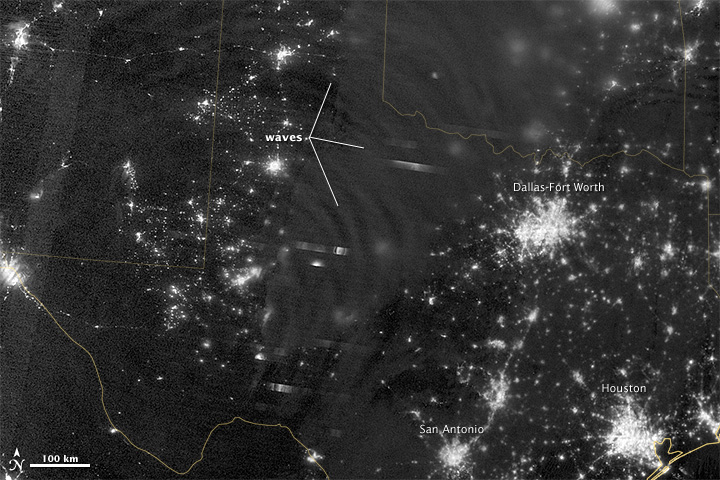Amazing Image: Eerie Nightglow Over Texas

The moon and stars may hog all the glory, but they’re not the only light in the sky at night. The air itself glows from chemical reactions between oxygen and nitrogen and other molecules in the atmosphere.
The Suomi NPP satellite caught a massive thunderstorm making waves in the nightglow above Texas and Oklahoma on April 15, 2012. While nightglow is a well-known phenomenon, scientists were surprised at Suomi NPP's ability to detect it, according to NASA's Earth Observatory. During the satellite's check-out procedures, scientists thought this light source was a problem with the sensor until they realized that they were seeing the faintest light in the darkness of night, the Earth Observatory reported.
The strongest nightglow emissions occur between 53 and 60 miles (85 to 95 kilometers) above the Earth's surface, where enough molecules concentrate to release energy as light. Called chemiluminescense, the phenomenon is similar to the chemistry that lights up glow sticks or glow-in-the-dark stickers.
The day-night band of the Visible Infrared Imaging Radiometer Suite on the Suomi NPP satellite captured the glowing ripples. The day-night band detects lights over a range of wavelengths from green to near-infrared and can observe low-light signals. The absolute minimum detectable by the instrument is at the levels of nightglow emission.
This story was provided by OurAmazingPlanet, a sister site to SPACE.com. Reach Becky Oskin at boskin@techmedianetwork.com. Follow her on Twitter @beckyoskin. Follow OurAmazingPlanet on Twitter @OAPlanet. We're also on Facebook and Google+.
Get the Space.com Newsletter
Breaking space news, the latest updates on rocket launches, skywatching events and more!
Join our Space Forums to keep talking space on the latest missions, night sky and more! And if you have a news tip, correction or comment, let us know at: community@space.com.

Becky was a science reporter at The Pasadena Star-News. She has freelanced for New Scientist and the American Institute of Physics and interned at Discovery News. She earned a master's degree in geology from Caltech, a bachelor's degree from Washington State University, and a graduate certificate in science writing from the University of California, Santa Cruz. To find out what her latest project is, you can follow Becky on Twitter.










